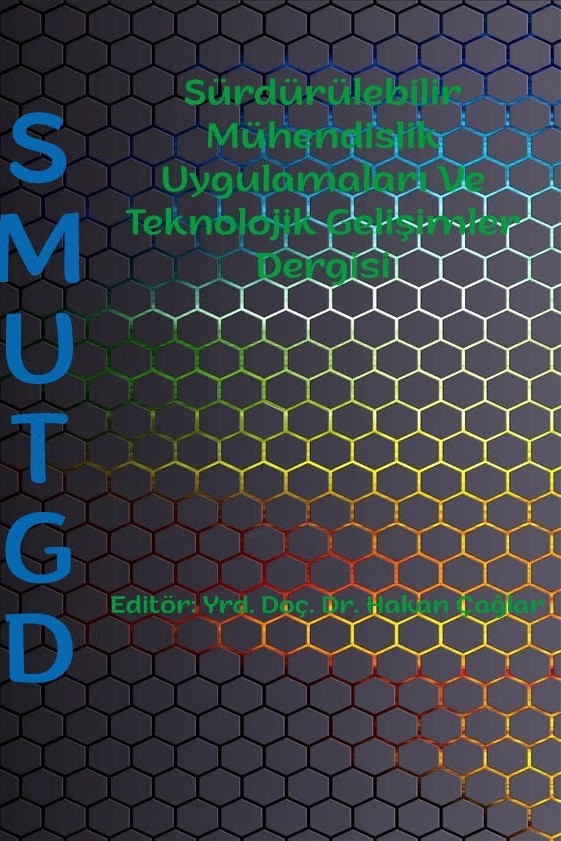Geopolimer Tuğla Üretiminde Atık Kullanımı Üzerine Yapılan Akademik Çalışmalar
Atık, tuğla, geopolimer tuğla, endüstriyel atık
Academic Studies On The Use Of Waste In Production Of Geopolymer Brick
Waste, brick, geopolymer brick, industrial waste,
___
- Rahman, M. E., Ong, P. J., Nabinejad, O., Islam, S., Khandoker, N. A. N., Pakrashi, V., Shorowordi, K. M., 2018, Utilization of blended waste materials in bricks, Technologies, 6(1), 20.
- Houben, H. and Guillaud, H., 1994, Earth construction: A Comprehensive Guide, London.
- Niroumand, H., Zain, M.F.M., Alhosseini, S.N., 2013, The influence of nano-clays on compressive strength of earth bricks as sustainable materials. Procedia Social and Behavioral Sciences, (89), 862– 865.
- Shakir, A. A., Naganathan, S. K., Mustapha, K. N. B., 2013, Development of bricks from waste material: A review paper. Australian Journal of Basic and Applied Sciences, 7(8), 812-818.
- Ahmad, M. and Rasid, K., 2022, Novel approach to synthesize clay-based geopolymer brick: Optimizing molding pressure and precursors’ proportioning. Construction and Building Materials, 322 (2022), 126472.
- Turan, E., 2019, Bor Atığı Kil Pestillerinin Mühendislik Özellikleri Ve Yüksek Plastisiteli Kilin Stabilizasyonunda Kullanılabilirliği, Yüksek Lisans Tezi, Atatürk Üniversitesi Fen Bilimleri Enstitüsü.
- Madani, H. Ramezanianpour, A.A., Shahbazinia, M., Ahmadi, E., 2020, Geopolymer bricks made from less active waste materials, Construction and Building Materials, 247 (2020), 118441.
- Gencel, O., Sütçü, M., Erdoğmuş, E., Koc, V., Çay, V.V., Gök, M.S., 2013, Properties of bricks with waste ferrochromium slag and zeolite, Journal of Cleaner Production, 59 (2013), 111–119.
- Ibrahim, W.M.W., Hussin, K., Abdullah B.M.M., 2015, A review of fy ash-based geopolymer lightweight bricks, Applied Mechanics and Materials, 452–456.
- Horel, C., 2012, Sodyum Hidroksit ve Soydum Silikat ile Aktive Edilmiş Taban Külünün Çimentoya Etkisi ve Geopolimerik Tuğla Üretimi, Afyon Kocatepe Üniversitesi Malzeme Bilimi ve Mühendisliği Lisans Tezi, Afyon.
- Zeybek, O., 2009, Uçucu Kül Esaslı Geopolimer Tuğla Üretimi, Yüksek Lisans, Tezi, Anadolu Üniversitesi Fen Bilimleri Enstitüsü.
- Abbas, S., Saleem, M. A., Kazmi, S.M.S. ve Munir, M. J., (2017). Production of sustainable clay bricks using waste fly ash: mechanical and durability properties. Journal of Building Engineering, 14, 7-14.
- Çimen, S., Çağlar, H., Çağlar, A., Can, Ö., 2020, Effect of Boron Wastes on the Engineering Properties of Perlite Based Brick. Turkish Journal of Nature and Science, 9(2), 50-56.
- Kumarasamy, V., Sampath, R., Kandasamy, S., 2021, Experimental Study on Hardened Mechanical and Durability Properties of Industrial Ash Bricks. Iranian Journal of Science and Technology, Transactions of Civil Engineering, 1-8.
- Prathyusha, P., Ramujee, K., 2020, The Development and Study of Fiber Reinforced Fly Ash Bricks. Advances in Civil Engineering, Conference, 177-187.
- Waheed, A., Azam, R., Riaz, M.R., Zawam, M., 2022, Mechanical and durability properties of fy ash cement sand composite bricks: an alternative to conventional burnt clay bricks, Innovative Infrastructure Solutions, (2022), 7-24.
- Çağlar, H., 2021, Investigation of the effect of fly ash and boron waste additive on brick structure material, Turkish Journal of Nature and Science, 10(1), 137-143.
- Ranjitham, M., Vishvapriya, M., Pavya, K., 2021, Experimental Investigation on Geopolymer Bricks, Advances in Civil Engineering, Conference, 97-106.
- Kang, X., Gan, Y., Chen, R., Zhang, C., 2021, Sustainable eco-friendly bricks from slate tailings through geopolymerization: synthesis and characterization analysis, Construction and Building Materials, 278, (2021), 122337.
- Singh, B.K. and Sengupta, S., 2022, An overview of fly ash utilization in production of geopolymer bricks and various factors influencing its strength, Innovative Infrastructure Solutions, 7 (283), 1-13.
- Madani, H. Ramezanianpour, A.A., Shahbazinia, M., Ahmadi, E., 2020, Geopolymer bricks made from less active waste materials, Construction and Building Materials, 247 (2020), 118441.
- Amin, S.K., Sherbiny, AboEl–Magd, S.E.A., Belal, A., Abadir, M.F. (2017). Fabrication of geopolymer bricks using ceramic dust waste, Construction and Building Materials, 157 (2017), 610-620.
- ISSN: 2651-3544
- Yayın Aralığı: Yılda 2 Sayı
- Başlangıç: 2018
- Yayıncı: Hakan ÇAĞLAR
Türkiye Yağış Şiddeti Serilerinin Homojenlik Analizi
Utku ZEYBEKOĞLU, Aslı ÜLKE KESKİN
Geopolimer Tuğla Üretiminde Atık Kullanımı Üzerine Yapılan Akademik Çalışmalar
Shahad Nadhım Abbas AL AMARA, Arzu ÇAĞLAR
BİR TEKSTİL İŞLETMESİNİN BOYAHANE BÖLÜMLERİNDE YAPILAN VERİMLİLİK ÇALIŞMALARININ İNCELENMESİ
Sultan ARAS ELİBÜYÜK, Şaban YUMRU, Mustafa ÇÖREKCİOĞLU
CAM ELYAF TAKVİYELİ PRECAST BETON CEPHE PANELLERİNİN UYGULANIŞI (ANKARA ÖRNEKLEMİ)
Abdulgader BERRANİ, Hakan ÇAĞLAR, Arzu ÇAĞLAR
Elektrikle Çalışmalarda İş Sağlığı ve Güvenliği Üzerine Bir Değerlendirme
Aslı Ece ACAR FİLİZCİ, Babek ERDEBİLLİ
Öğütülmüş Pomza Tozlu Harçların Hidroklorik Asit Direncinin İncelenmesi
Meryem Rumeysa KAYIHAN, Behcet DÜNDAR, Emriye ÇINAR RESULOĞULLARI
Exploration of the Effect of Carbon Fiber Ratio and Dimensions on Electrical Conductivity in Mortars
Hacer UZUNALİOĞLU, Salih YAZICIOĞLU, Adem AHISKALI, Hakan ÇAĞLAR
Sürdürülebilir Yağmur Suyu Hasadı Üzerine Yapısal Bir İnceleme
Pınar SELİMOĞLU, Ruşen YAMAÇLI
SURDURULEBILIR VE ESNEK MIMARI YAKLAŞIMLARINA TARIHSEL SUREÇTE KURAMSAL BIR BAKIŞ
